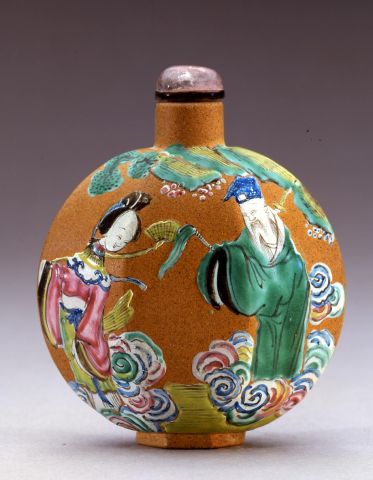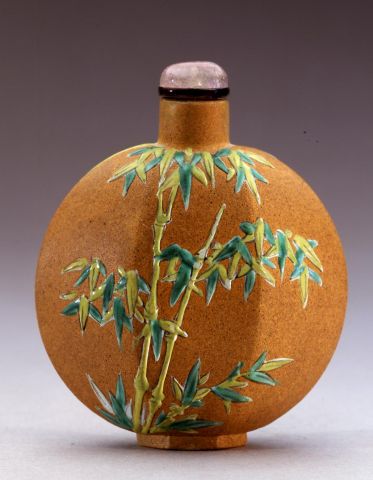

Bottle ID: 134
LIGHT TAN WITH ENAMELED FIGURES
Date: 1820-1860
Height: 58 mm
Stoneware, of flattened hexagonal form with vertical panels, enameled on one side with two immortals upon clouds with pine and rocks in the background, the reverse with a leafy bamboo grove, on a pale beige ground.
Attributed to Yixing.
Similar Examples:
Crane Collection no. 311
Sotheby's, New York, October 27, 1986, lot 24, Collection of Janos Szekeres, Part I.
The Art of the Yixing Potter. The K. S. Lo Collection, 1990, p. 98, no. 53.
Provenance:
Clare Lawrence Ltd.
Christie's, Swire, Hong Kong, April 1st, 1992, lot 1537
The clay found in the mountains of Yixing has a high iron content of around 9%. It is flexible, and although porous does not soften easily with the addition of water. This makes it highly plastic and suitable for wares such as teapots which are hand built, rather than wares produced on the potter’s wheel. Yixing wares are produced, even today, by hand with a set of tools made of bamboo, wood, horn and metal. Other than teapots, the potters produced items for the scholar’s desk such as brush rests, seal paste pots and snuff bottles although these were in far smaller quantities than the tea-wares. The colors of “purple clay” can be divided into three tones – zisha or purple clay, zhusha or orange-red clay and banshanlu ni or yellow (buff) clay. In addition to these natural colors, mineral colors can be added to create an infinite range of colors from black to red to pale yellow.
This nineteenth century example is exceptional in its evolution from earlier wares. In addition to the rare use of the yellow clay, its form is taken from the highly geometric styles of eighteenth century teapots and its decoration uses the famille rose enamelled style that appeared in the previous century on these wares.

 English
English 中文
中文